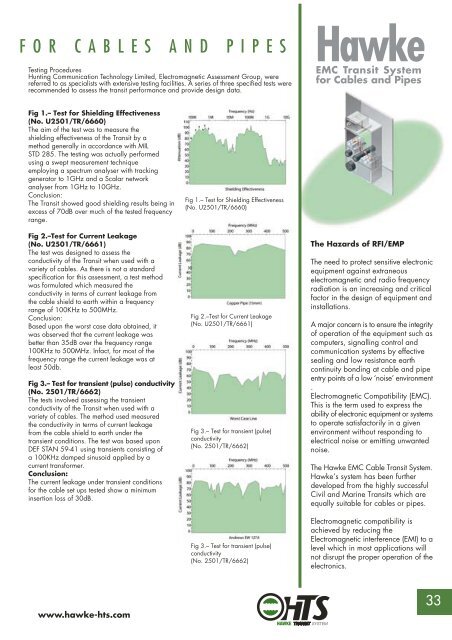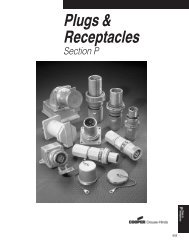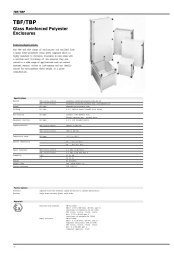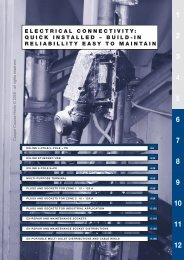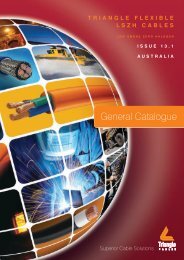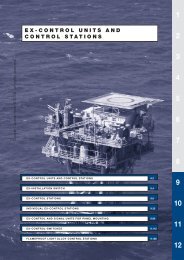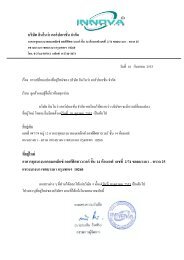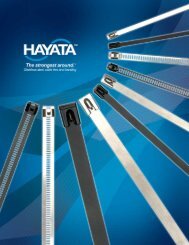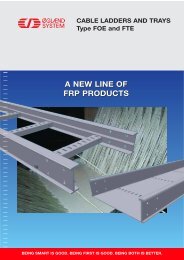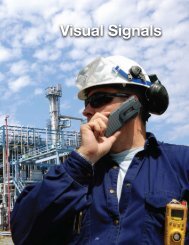Hawke Transit System catalogo
Hawke Transit System catalogo
Hawke Transit System catalogo
- No tags were found...
Create successful ePaper yourself
Turn your PDF publications into a flip-book with our unique Google optimized e-Paper software.
F O R C A B L E S A N D P I P E STesting ProceduresHunting Communication Technology Limited, Electromagnetic Assessment Group, werereferred to as specialists with extensive testing facilities. A series of three specified tests wererecommended to assess the transit performance and provide design data.<strong>Hawke</strong>EMC <strong>Transit</strong> <strong>System</strong>for Cables and PipesFig 1.– Test for Shielding Effectiveness(No. U2501/TR/6660)The aim of the test was to measure theshielding effectiveness of the <strong>Transit</strong> by amethod generally in accordance with MILSTD 285. The testing was actually performedusing a swept measurement techniqueemploying a spectrum analyser with trackinggenerator to 1GHz and a Scalar networkanalyser from 1GHz to 10GHz.Conclusion:The <strong>Transit</strong> showed good shielding results being inexcess of 70dB over much of the tested frequencyrange.Fig 2.–Test for Current Leakage(No. U2501/TR/6661)The test was designed to assess theconductivity of the <strong>Transit</strong> when used with avariety of cables. As there is not a standardspecification for this assessment, a test methodwas formulated which measured theconductivity in terms of current leakage fromthe cable shield to earth within a frequencyrange of 100KHz to 500MHz.Conclusion:Based upon the worst case data obtained, itwas observed that the current leakage wasbetter than 35dB over the frequency range100KHz to 500MHz. Infact, for most of thefrequency range the current leakage was atleast 50db.Fig 3.– Test for transient (pulse) conductivity(No. 2501/TR/6662)The tests involved assessing the transientconductivity of the <strong>Transit</strong> when used with avariety of cables. The method used measuredthe conductivity in terms of current leakagefrom the cable shield to earth under thetransient conditions. The test was based uponDEF STAN 59-41 using transients consisting ofa 100KHz damped sinusoid applied by acurrent transformer.Conclusion:The current leakage under transient conditionsfor the cable set ups tested show a minimuminsertion loss of 30dB.Fig 1.– Test for Shielding Effectiveness(No. U2501/TR/6660)Fig 2.–Test for Current Leakage(No. U2501/TR/6661)Fig 3.– Test for transient (pulse)conductivity(No. 2501/TR/6662)Fig 3.– Test for transient (pulse)conductivity(No. 2501/TR/6662)The Hazards of RFI/EMPThe need to protect sensitive electronicequipment against extraneouselectromagnetic and radio frequencyradiation is an increasing and criticalfactor in the design of equipment andinstallations.A major concern is to ensure the integrityof operation of the equipment such ascomputers, signalling control andcommunication systems by effectivesealing and low resistance earthcontinuity bonding at cable and pipeentry points of a low ‘noise’ environment.Electromagnetic Compatibility (EMC).This is the term used to express theability of electronic equipment or systemsto operate satisfactorily in a givenenvironment without responding toelectrical noise or emitting unwantednoise.The <strong>Hawke</strong> EMC Cable <strong>Transit</strong> <strong>System</strong>.<strong>Hawke</strong>’s system has been furtherdeveloped from the highly successfulCivil and Marine <strong>Transit</strong>s which areequally suitable for cables or pipes.Electromagnetic compatibility isachieved by reducing theElectromagnetic interference (EMI) to alevel which in most applications willnot disrupt the proper operation of theelectronics.www.hawke-hts.com33


